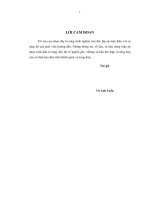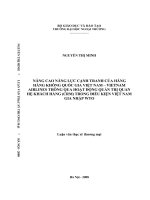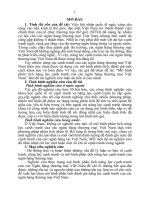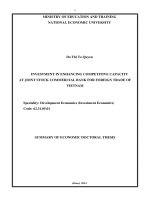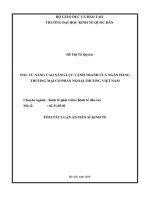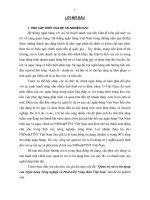tóm tắt tiếng anh quản lý tài chính góp phần nâng cao năng lực cạnh tranh của các tập đoàn kinh tế việt nam
Bạn đang xem bản rút gọn của tài liệu. Xem và tải ngay bản đầy đủ của tài liệu tại đây (417.33 KB, 24 trang )
1
PREFACE
1. URGENCY OF RESEARCH THEME:
The banking system which is the life-line of the economy always plays an
important role. Vietnam Banking system has attained encouraging achievements such
as contribution to inflation stability and repression and effective implementation of
national monetary policy for the last years. However, in the market economy,
business risk is unavoidable, especially banking business risk because it is able to
cause chain reaction, spread and represent more complexity. The collapse of bank
affects the whole life – economy – politics – society in negative way and may spread
out of a country even a region and global.
In front of the integration trend, financial and banking institutions will always
deal with competition and different risk types as well. In Vietnam, because the point
of departure of domestic banks is rather low compared to the average of the region,
focusing on development and taking interest in profit are firstly priority. This leads to
which the risk management of Vietnam banks is almost left open and not invested in
construction in satisfactory and professional manner. This is the reason why the bad
debt ratio and many problems occurred due to uncontrollability that are becoming a
question without answer in most of Vietnam banks and even in Vietnam Bank for
Agriculture and Rural Development, a financial institution mainly operating in
agriculture and rural field. The profits of Vietnam Bank for Agriculture and Rural
Development are mainly from credit activities (account for 90% total income of the
Bank). Therefore, the credit risk management plays the decisive role in existence and
growth of Vietnam Bank for Agriculture and Rural Development.
In order to restrict risks in credit activities, it is necessary to build up and
promulgate a credit risk management strategy in accordance with principles and
standards of modern bank.
As practical requirements above, the writer chooses “Credit risk management
of Vietnam Bank for Agriculture and Rural Development” as the research theme.
2. PURPOSE OF RESEARCH:
- It is to interpret and systematize basic theory matters of risk management in
general as well as bank credit risk in particular.
2
- It is to research contents regarding the credit risk management, experience of
developed countries, international practices and referential lesson ability, applicable
to Vietnam Commercial Banks in general and Vietnam Bank for Agriculture and
Rural Development in particular.
- On the basis of practical theory and situation and specificity analysis of
operation of Vietnam Bank for Agriculture and Rural Development to build up an
effective credit risk management strategy, and propose solutions and
recommendations to perfect and improve the effectiveness of credit risk management
of Vietnam Bank for Agriculture and Rural Development.
3. OBJECT AND SCOPE OF RESEARCH:
- The object of research is the credit risk management in Vietnam Bank for
Agriculture and Rural Development.
- The scope of research is to focus on research into credit risk management in
general and assess the credit risk management in Vietnam Bank for Agriculture and
Rural Development. The data is concentrated in the period 2005-2010.
4. RESEARCH METHODS:
The Thesis approaches the object of research on the basis of applying and
collecting economic scientific research methods, from dialectical materialism,
historical materialism, summary, analysis and comparison methods to practical
summary survey, comparision of practice to theoretical frame on credit risk
management of countries in the world and at home for argument, and then proposes
the construction of credit risk management models for Vietnam Bank for Agriculture
and Rural Development.
5. THESIS STRUCTURE:
Apart from the preface, conclusion, references, list of tables and diagrams, the
main contents of the Thesis include about 210 pages divided into 3 chapters as
follows:
Chapter 1: Credit risk management at Commercial Banks
Chapter 2: Situation of risk management of Vietnam Bank for Agriculture
and Rural Development
Chapter 3: Credit risk management improvement of Vietnam Bank for
Agriculture and Rural Development
3
CHAPTER 1:
CREDIT RISK MANAGEMENT AT COMMERCIAL BANKS
1.1. BUSINESS RISK OF COMMERCIAL BANKS:
1.1.1. Business risk of Commercial Banks:
1.1.1.1. Definition of risk:
Risk means the probability of uncertain events in future that makes the subject
cannot reach its strategic and operating targets as well as opportunity cost of losing
market opportunities.
1.1.1.2. Basic risks of Commercial Banks:
1.1.2. Credit activities and credit risks of Commercial Banks:
1.1.2.1. Overview of credit activities of Commercial Banks:
“Credit activities mean that Commercial Banks use their equity capital and
mobilized capital to grant credit for their customers using an amount with the
principle of redemption through lending, discount, financial leasing, bank guarantee
and other related operations”.
1.1.2.2. Definition of banking credit risk:
Credit risk means the risk and loss of finance (direct or indirect) stemming
from a borrower’s failure to fulfill a loan repayment as agreed or insolvency.
(See the diagram 1.3 overleaf)
1.1.2.3 Reasons for credit risk:
In this part, the Thesis clearly analyzes objective reasons and reasons from the
lending bank.
1.1.2.4. Some basic identification signs of credit risk:
1.1.2.5. Credit risk measurement:
1.1.2.6. Consequence of credit risk for banking: The Thesis analyzes it for the
economy and the bank.
4
Diagram 1.3: Process of arising credit risks at Commercial Banks [17]
1.2. CREDIT RISK MANAGEMENT OF COMMERCIAL BANKS:
1.2.1 Definition of credit risk management:
According to the Thesis, credit risk management means a process of building
and implementing strategies, policies and methods relating to credit activities to
prevent and limit banking credit risk.
1.2.2. Role of credit risk management for Commercial Banks:
1.2.3. Contents and standards of credit risk management in accordance with
the Basel Committee:
1.2.3.1. Contents of credit risk management: The credit risk management
includes the following contents: Credit policy; Credit procedure; Risk identification
related to borrowing customers; Customer scoring; Debt classification; Credit control
system; Provision and risk treatment policy; and Implementation of applying credit
risk measurement tools.
1.2.3.2. Standards of credit risk management according to Basel Committee
on Banking Supervision:
Reduced solvency, reduced
production and business efficiency,
capital loss, bankruptcy
Failure to
receive
interest
Failure to
receive capital
Failure to
receive
enough
interest
Failure to receive
enough lending
capital
Arising accrued
interest
Arising
overdue debt
Arising frozen
accrued interest
Arising
bad debt
Credit risks
5
a. Standards of credit risk management according to Basel I: The Thesis
focuses on analyzing 4 standards regarding the credit risk management, including
Credit grant standard and credit supervision procedure; Asset quality assessment and
loan loss provision; risk concentration and big risks; and lending related customers.
b. Standards of credit risk management according to Basel II: The Thesis
analyzes two contents as following: Standardized approach to credit risk; and internal
ratings based approach (according to Paragraph 18, 19 and 20 Basel II).
1.2.4. Factors influence the credit risk management:
The Thesis analyzes factors of mechanism, policy and model of bank credit
risk management; man factor including officials of Commercial Banks and
borrowers; and technology factor.
1.2.5. Assessment indicators of credit risk management effectiveness of
Commercial Banks:
1.2.5.1. Quantitative indicators:
• General operating quality group:
Indicator 1: Loan outstanding and the customer’s loan outstanding growth rate
Indicator 2: Profitable loan outstanding ratio
Indicator 3: Execution and implementation of lending policies and activities.
• Capital-use safety indicator group:
Indicator 1: Overdue debt ratio
Indicator 2: Bed debt ratio. Substandard debt (Category 3); Doubtful debt
(Category 4); Loss debt (Category 5)
• Profit indicator group:
Indicator 1: Gross lending profit;
Indicator 2: Net profit before taxed;
Indicator 3: Net profit after taxed;
Indicator 4: Return on assets and return on equity;
Indicator 5: Input and output interest rate spread in production household credit;
Indicator 6: Loan interest receipt ratio.
6
1.2.3.2. Qualitative indicators for effectiveness assessment of credit risk
management of Commercial Banks: The Thesis researches in the angle of influence on
borrowers, economy and banks.
1.3 INTERNATIONAL EXPERIENCE IN CREDIT RISK MANAGEMENT AND
EXPERIENCE LESSON FOR VIETNAM:
1.3.1 Experience in credit risk management of Thailand Banks
1.3.2
. Experience of ANZ Banking Group Ltd
1.3.3. Experience of other banks in the world
1.3.4. Experience lesson for Vietnam:
1.3.4.1. The experience lesson learnt from the experience of some international
institutions and Commercial Banks in the world:
Firstly, absolutely applying golden principles of credit risk management according
to Basel Committee.
Secondly, building up a system of key risk indicators (KRIs), quantifying credit
risk according to AMA; combining qualitative indicators (self-assessment and self-
inspection) and quantitative indicators, and calculating likelihood.
Thirdly, building consciousness of credit risk management in the whole system,
choosing priority fields to establish control points of credit risk.
Fourthly, building a data bank on credit risk and using modern technology in
analysis/treatment of credit risk.
Fifthly, minimizing causes of credit risk made from internal factors of
Commercial Banks such as people, procedures and system.
Finally, minimizing causes of credit risk made from the external.
1.3.4.2. Experience lesson learnt from Vietnamese Commercial Banks for
Vietnam Bank for Agriculture and Rural Development:
Firstly, building credit procedure that specifies responsibilities of relating
departments;
Secondly, building the indicator system to score customers;
Thirdly, using support measures;
Fourthly, strengthening information collection and storage, and loan supervision;
Fifthly, establishing a qualified, competent and professional ethic department of
credit risk management;
7
CHAPTER 2:
SITUATION OF CREDIT RISK MANAGEMENT OF VIETNAM BANK FOR
AGRICULTURE AND RURAL DEVELOPMENT
2.1. OVERVIEW OF VIETNAM BANK FOR AGRICULTURE AND RURAL
DEVELOPMENT
2.1.1. Formation and development of Vietnam Bank for Agriculture and
Rural Development: [13]
2.1.2. Overview of Vietnam Bank for Agriculture and Rural Development:
2.1.3. Human resources:
2.1.4. Services and products of Vietnam Bank for Agriculture and Rural
Development:
2.1.5. Main business result of Vietnam Bank for Agriculture and Rural
Development:
2.1.5.1. Assessment of implementation result of business strategy in period
2001 – 2010 of Vietnam Bank for Agriculture and Rural Development:
Table 2.1. Implementation result of some operating indicators of Vietnam Bank for
Agriculture and Rural Development in the period 2005 - 2010
Unit: percentage and trillion dongs
2005 2010
Items
Plan
Implem
entation
Plan
Implemen
tation
Equity capital 7 - 10 7,7 15 – 17 32,6
Capital safety ratio 8% 4,5% 8% 7,07%
Service turnover ratio / total net turnover 20% - 30% 6,9% 30% - 40% 11,9%
Return on capital 14% 4,79% 14% 12,9%
Loan outstanding 170 -175 180 312-400 415
Loan outstanding of financial leasing 8 3,8 15 - 20
Loan growth rate 20% - 22% 15% 18% - 20% 17%
Density of loan outstanding/
customer’s deposit
80% - 90% 88,8% 70% - 80% 96,5%
Medium and long-term loan ratio 45% 43,6% < 40% 39%
Bad debt and overdue debt ratio 4% 2,3% < 4% 3,7%
Total capital 196 - 206 190 394 - 512 475
Capital growth rate 22% - 25% 20% 20% - 22% 9,4%
Proportion of residential savings
deposit and time deposit/Total capital
50% - 60% 41% 40% - 50% 44%
Proportion of demand deposit, balance
of clearing account/Total capital
15% - 20% 28% 20% - 25% 24%
(Source: Business activities statement of Vietnam Bank for Agriculture and Rural
Development in the period 2005 – 2010) [14]
8
2.1.5.2. Capital activities:
Source: Report from the State Bank of Vietnam’s Credit Department
Diagram 2.1: Capital market share of Vietnam Bank for Agriculture and
Rural Development compared to other financial institutions
2.1.5.3. Credit activities:
27%
16.10%
15.80%
11.50%
29.60%
Agribank
VietinBank
BIDV
VCB
Các NHTMCP khác
Diagram 2.2: Lending market share of Vietnam Bank for Agriculture and
Rural Development compared to other financial institutions
Source: Report from the State Bank of Vietnam’s Credit Department 2.1.5.4.
Debt restructuring, financial healthy making:
2.1.5.5. Guarantee activities:
2.2. SITUATION OF CREDIT RISK MANAGEMENT IN VIETNAM BANK FOR
AGRICULTURE AND RURAL DEVELOPMENT FOR THE LAST TIME:
2.2.1. Model of credit risk management: (See diagram 2.3)
2.2.2. Credit mechanism and policy for customer:
It is possible to say that credit procedure and other internal procedure directly
related to credit activities are timely and fully issued by Vietnam Bank for
9
Agriculture and Rural Development suitable to its operation and based on Decisions
of the State Bank Governor and other legal regulations.
Diagram 2.3: Model of credit risk management at Vietnam Bank for Agriculture
and Rural Development [14]
2.2.3. Credit operation procedure:
Vietnam Bank for Agriculture and Rural Development authorizes branches to
approve credit grant basing on credit rank of customers and each respective branch.
Diagram 2.4: Credit grant procedure [14]
Customer
Credit Department –
Operation Center
General
Director
Director
Leader of Credit
Department
Credit
officer
Branch
Within decision-
making right
Beyond
decision-
making right
OPERATION
CENTER
CREDIT
DEPARTMENT
INTERNAL INSPECTION
AND SUPERVISION
DEPARTMENT
RISK PREVENTION
& TREATMENT
CENTER
BRANCHES GRADE 1
10
2.2.4. Information of credit risk prevention: At Vietnam Bank for Agriculture
and Rural Development, the Risk prevention and Treatment Center focuses on
procession and supply of customer information of the whole system.
2.2.5. Customer scoring and ranking system:
Today, customer scoring and ranking are implementing in accordance with the
Dispatch No. 1406/NHNo-TD dated 23rd May, 2007 of the General Director. Until
31st December, 2010, Vietnam Bank for Agriculture and Rural Development has
basically completed the customer scoring in accordance with regulations of the State
Bank of Vietnam and approaching to the international practice.
2.2.6. Lending method and agricultural – rural credit mechanism:
In addition to credit activities for enterprises, business households and urban
households, credit for production household and agriculture – rural can be considered
as the biggest credit market of Vietnam Bank for Agriculture and Rural
Development. Therefore, in credit management, Vietnam Bank for Agriculture and
Rural Development has specific method and implements separate mechanism for
credit in such field. For agricultural and rural loans, Vietnam Bank for Agriculture
and Rural Development effectively implements the Decision No. 67/TTg of the
Prime Minister and other related legal documents.
2.2.7. Debt classification and bad debt management:
Branches of Vietnam Bank for Agriculture and Rural Development are making
debt classification, provision and credit risk treatment in accordance with Decision
No. 636/2007/QD-HDQT-XLRR dated 22nd June, 2007 of the Board of Directors of
Vietnam Bank for Agriculture and Rural Development.
11
Table 2.9: Asset quality of Vietnam Bank for Agriculture and Rural Development
in the period 2007 - 2010
Unit: billion dongs; %
Items 2007 2008 2009 2010
Total assets 326,897
400,485
480,963
542,166
Non-profit debt (bad debt) 5,048
9,575
15,259
22.280
Ratio of Non-profit debt/Loan
outstanding 2.01
3.25
4.12
5.25
Ratio of Provision/Non-profit
debt 91.48
58.31
40.99
54.89
Ratio of Risk asset/ Total assets 87.73
84.28
86.51
85.25
(Source: Annual report of Vietnam Bank for Agriculture and Rural Development in
the period 2007 – 2010) [13]
2.2.8. Credit risk at Vietnam Bank for Agriculture and Rural Development:
Table 2.10: Bad debt of Vietnam Bank for Agriculture and Rural Development in
the period 2005 – 2010
Unit: billion dongs, %
Items 2007 2008 2009 2010
Loan
outstan
ding
Ratio Loan
outstan
ding
Ratio Loan
outstan
ding
Ratio Loan
outstan
ding
Ratio
Not due debt 237.591
98,1
281.335
97,4
349.638
97,42
405.755
96,31
Bad debt 4.589
1,9
7.541
2,6
9.266
2,58
15.576
3,69
Total 242.180
288.876
358.904
421.331
(Source: Annual report of Vietnam Bank for Agriculture and Rural Development in
the period 2007 - 2010) [13]
12
Table 2.11: Bad debt ratio of Vietnam Bank for Agriculture and Rural
Development in the period 2005 -2010
Unit: billion dongs
Items 2005 2006 2007 2008
2009 2010
Bad debt / Overdue debt 3.689 3.503 4.589 7.699
9.266
15.575
Ratio of Bad debt/ Total debt 2,3% 1,9% 1,9% 2,7% 2,6% 3,7%
(Source: Annual report of Vietnam Bank for Agriculture and Rural
Development in the period 2005 - 2010) [13]
2.2.9. Risk provisioning and credit risk treatment:
Table 2.13: Result of provisioning and risk provision treatment of Vietnam Bank
for Agriculture and Rural Development in the period 2007 - 2010
Unit: billion dongs
Items 2007 2008 2009 2010
- Provisioning amount 6.291
7.410
4.055
6.500
- Risk treatment 4.226
6.609
4.110
473
- Debt collection after risk
treatment
2.842
3.306
4.012
2.834
(Source: Report on provisioning and credit risk treatment of Vietnam Bank for
Agriculture and Rural Development in the period 2005 – 2008) [14]
2.2.10. Recovery of debts treatd risk
In 2008, total recoveries of debts after risk treatment of Vietnam Bank for
Agriculture and Rural Development were 3,307 billion dongs. In 2007, they
were 2,821 billion dongs, exceeding 87% in comparison with the plan. In 2009,
Vietnam Bank for Agriculture and Rural Development specially succeeded in
debt recovery after risk treatment with an amount of 4,012 billion dongs that
was the highest figure of debt recoveries since its establishment. In 2010, the
debt recovery after risk treatment was 2,834 billion dongs that is smaller than
that of 2009, however, in comparison with other Commercial Banks, this is an
impressive figure.
13
2.3 ASSESSMENT ON SITUATION OF CREDIT RISK MANAGEMENT AT
VIETNAM BANK FOR AGRICULTURE AND RURAL DEVELOPMENT:
2.3.1 Achievements:
- Credit risk management of Vietnam Bank for Agriculture and Rural
Development is more and more effective, contributing to improve its stable business
efficiency and promote socio-economic development especially agriculture – rural
and farmers.
- Risk management model of Vietnam Bank for Agriculture and Rural
Development has been renovated very much in accordance with operational
requirements and international practices
- For use of reserve fund of credit risk: Branches under Vietnam Bank for
Agriculture and Rural Development are entitled to use the reserve fund of credit risk
once each quarter for debt treatment such as debt of category 5; debt of organizations
and enterprises who are dissolved or went bankruptcy as per legislation; and
individual who is died or went missing.
- Customer’s credit mechanisms and policies are issued in accordance with
State regulations gradually match credit practice in the region and in the world as
well.
- Credit grant procedure is now clearly regulated.
- Customer scoring and ranking system is setting gradually towards
international practice. Debt classification and bad debt management are made in
accordance with the State Bank of Vietnam’s guidance.
- There are abundant employees whose qualification is more intensive and
awareness of credit risk prevention is more improved. Ethic risk in credit of Vietnam
Bank for Agriculture and Rural Development is minimized.
- Credit inspection and supervision is continuously strengthened.
2.3.2 Limitations:
Although the owner’s equity was increased by many measures such as
provisioning from retained profit, general provision and issue of long-term
valuable papers, the capital safety ratio was 7.07% smaller than 0.93%
compared to the regulation in the end of 2010. Profit after taxed/owner’s
equity is smaller that that of other Commercial Banks.
14
- Loan outstanding and investment structure/Total mobilized capital is
always over 85%. Medium and long-term capital is limited. Liability structure
is not managed well so that it often meets difficulty in liquidity at sensitive
time such as at the end of fiscal year.
- Management accounting system is not completed. Management of
liquidity risk, interest rate and exchange rate is not methodical and associated
with the structure, maturity period of capital, assets and foreign currency
status.
- Income over years is unstable. Net interest spread is low. Income
structure is not reasonablel. Loan interest is the main revenue source.
Receipts outside of credit are low and instable. Expected profit accounts for
high proportion
- Operating expenses and breakeven point are high. Operating expense
to total average asset ratio from 2001-2010 is over 2% per year. Expenditure
for credit risk provisioning is high with average of 1.77%/total loan
outstanding and investment.
- Model system of credit organization inherits the traditional credit model. Its
mechanisms and policies are not synchronized and not caught up with the
international practices
- The operation procedure is simple. Information technology for credit risk
prevention is limited. The customer scoring and ranking system has not assessed
customer’s capability incorrectly; and its application into practice is formalistic.
Human resources are not strong enough in the integration period.
- Debt classification is not incomply made. Provisioning and risk treatment is
not perfect.
2.3.3. Causes for above limitations at Vietnam Bank for Agriculture and
Rural Development:
2.3.3.1. Subjective causes:
Firstly: Model of credit organizational structure and credit risk management are
slowly renovated.
15
Secondly: Some regulations on credit management in general and credit risk
management in particular which are newly promulgated are unsuitable and
unsatisfactory to the international integration requirement because they are not
aware of the importance of “safety” requirements in credit activities.
Thirdly: Interest rate risk and decrease in profitability efficiency of credit
capital stem from that there are no specific regulations on selection and application
of floating lending interest mechanism.
Fourthly: Inspection and supervision abilities of the implementation of credit
risk management targets and contents are limited.
Fifthly: Human resources have not very high quality and have not used
suitably. Employees are crowded and aged.
2.3.3.2. Objective causes:
Firstly, its mechanism and policies are unsuitable and slowly implemented.
Secondly, the regulation on risk provision is large different compared to the
international practices.
Thirdly, some regulations on loan guarantee and guarantee assets lack of
clear guidances.
Fourthly, socio-economic and natural environment is complicatedly changed
and difficult to forecast.
Fifthly, natural disaster often occurs on a large scale in many places, causing
damages to asset and people’s life and seriously affecting the credit risk
management, but agricultural insurance has not been developed yet.
16
CHAPTER 3:
CREDIT RISK MANAGEMENT IMPROVEMENT OF VIETNAM BANK FOR
AGRICULTURE AND RURAL DEVELOPMENT
3.1. ANALYSIS OF STRENGTHS, WEAKNESSES, OPPORTUNITIES AND
THREATS (SWOT) OF VIETNAM BANK FOR AGRICULTURE AND RURAL
DEVELOPMENT:
3.1.1. Opportunities:
- Vietnam’s integration is wider and deeper.
- Scientific and technological progress quickly develops.
- Vietnam’s economy always reaches high growth rate.
- Vietnam has stable and safe financial environment.
- The Government continues to confirm the reform policy.
- The population of Vietnam is crowded; however, the rate of people having bank
account is low.
3.1.2. Threats:
- All economic, political and social changes in the world generally and in large
countries particularly directly affect Vietnam.
- Operating requirements for foreign banks are loosened.
- There are many competitors, especially joint-stock banks.
- A large volume of idle money is now invested in different forms and channels
instead of deposit as before.
- Foreign and joint-stock banks particularly take interest in and invest in
completion of modern products and services.
5.1.3. Strengths:
- Vietnam Bank for Agriculture and Rural Development is the biggest
commercial bank on equity capital, network, people and assets.
- It always has a especially important position in development.
- It affirms the position, prestige and trademark of a leading commercial bank.
- It has absolute strength in distributionl network.
17
- It has a modern information technology infrastructure.
- Its business is multifunction, multisectoral and multi-disciplinary.
- Its staff is crowded and experienced.
3.1.4. Weaknesses:
- It has not met the minimumcapital adequacy ratio.
- Organization model at the Headquarter is incomplete and ineffective.
- Branch network in the urban zone has not been arranged.
- Products and services are not diversified.
- Technological application has not been developed completely.
- Current organization model and urban branch system and rural network
system uniformity are restraining its development.
- It is short of skilled officers adapting to competitive environment and being in
conformity with the integration trend.
3.2. STRATEGIC VISION UP TO 2015:
3.2.1. Operation guidelines:
It maintain to be the biggest commercial bank in Vietnam, doing multifunction
business but play decisive and main role in rural financial market, complete
privatization for subsidiary companies, and change into a leading multisectoral,
multidisciplinary and multiple ownership financial group in Vietnam.
3.2.2. General targets up to 2015
3.2.3. Operation principles:
3.3. BUSINESS ACTIVITIES’ ORIENTATION AND CREDIT RISK MANAGEMENT
OF VIETNAM BANK FOR AGRICULTURE AND RURAL DEVELOPMENT:
3.3.1. Business activities’ orientations:
With the guideline for prosperity and stable development of customers and
itself, the target of Vietnam Bank for Agriculture and Rural Development is to
continue to maitain its position as a leading commercial bank in Vietnam, advanced
in the region and prestigious in the world.
18
3.3.2. Credit risk management’s orientation:
Its business subject is currency – especially sensitive goods to risk; easy risk
spreading among commercial banks. It has many customers so that only one customer
who meets risk will affect the bank image in negative way.
3.4. CREDIT RISK MANAGEMENT IMPROVEMENT METHOD OF VIETNAM
BANK FOR AGRICULTURE AND RURAL DEVELOPMENT:
3.4.1. Strengthening capacity of credit risk management for managers and
operational officers of Vietnam Bank for Agriculture and Rural Development:
Human is always most important and decisive factor. Therefore, banks usually take
interest in strengthening their management capacity from managers to operational
officers.
3.4.2. Consolidating and improving credit quality to contribute to risk
restriction in business: Consolidating and improving credit quality are the survival
decisive factor in banking business quality. Good, safe and effective credit quality
means that credit risk will be minimized. However, in order to do so, it requires the
bank to complete from the stage of promulgating the lending mechanism and
procedure, and appraisal, inspection and supervision quality.
3.4.3. Strengthening risk management by identifying risk signs, building
early warning system to timely treat bad debts, and minimizing loss for the bank:
On the basis of identifying bank risk signs, it is necessary to urgently build up an
early warning system to treat risk and restrict loss for the bank.
3.4.4. Measuring current and future risk to provide methods for restricting
and limit risk: Firstly, measuring or determining loss made by the risk; and secondly,
measuring the possibility of risk.
3.4.5. Setting up a model of centralized credit management: Setting up such
model will assist Vietnam Bank for Agriculture and Rural Development in fully
extracting credit information, inspecting and supervising credit activities from the
Headquarter, and forecasting and preventing risk from a distance. Particularly, the
bank information administration software system and bank information software are
19
implemented synchronously. As a result, it will ensure the data management,
centralized handling, and information effectiveness and quality improvement.
3.4.6. Changing the organizational structure, functions and tasks satisfying
to requirements on credit risk management:
(See the diagram 3.1)
Diagram 3.1. Organizational model of credit risk management
Notes:
- Line Management relation, direct management
- Line Inspection and supervision combination relation
3.4.7. Promulgating credit procedures as the direction of assigning
responsibilities for each department: Vietnam Bank for Agriculture and Rural
Development should have clear procedures for approving new credit, as well as
amending, extending and re-sponsoring current credit.
3.4.8. Improving quality of credit inspection and supervision, strengthening
the internal inspection and audit to early identify credit risk: It is necessary to
establish an effective credit inspection and supervision system in order to supervise
the capital movements from lending until debt collection from customers.
3.4.9. Setting and implementing uniformity of customer scoring and ranking
system: Setting and implementing uniformly customer scoring and ranking system to
SUPERVISION DEPARTMENT
OF
THE BOARD OF DIRECTORS
RISK MANAGEMENT
COMMITTEE
ALCO COMMITTEE BOARD OF MANAGERS
CUSTOMER DIVISION
CREDIT RISK
MANAGEMENT
POLICY
FORMULATI
ON
RISK
MANAGEMENT
IN SOUTHERN
RISK
MANAGEMENT
IN CENTRAL
REGION
RISK
MANAGEMENT
IN NORTHERN
RISK
MANAGEMENT
OF BRANCH
DIRECTOR
CUSTOMER DIVISION
BOARD OF DIRECTORS
20
evaluate implicit risk of each credit based on quantitative and qualitative indicators
system relating to borrowers. Article 7 of Decision 493 of the State Bank of Vietnam
is applied.
3.4.10. Completing and improving quality of customer credit information
center: It is a must to ensure that the Customer Information Center (CIC) must be
updated most quickly, completely and correctly for credit appraisal and issue
approval. Hence, this will limit credit risk for the whole system of Vietnam Bank for
Agriculture and Rural Development.
3.4.11. Establishing reserve fund for bad debts and overdue debts, and
actively settling bad debts and overdue debts: Practically, establishing reserve fund
has been carried out in Vietnam Bank for Agriculture and Rural Development.
However, it has no specific guidance for its branches to do so, as a result, the reserve
fund establishment is made incorrectly and affects its business. Therefore, it requires
the bank must improve the regulations guiding the debt classification and risk
provisioning that match with the regulations of the State Bank and its status of bad
debts at present.
3.4.12. Fully and synchronously applying modern information technology
into credit activities: In order to timely and completely control borrowers’
information flows at Vietnam Bank for Agriculture and Rural Development, it is
necessary to carry out the IPCAS program for all branches where have not used this
program.
3.4.13. Focusing on unpaid, bad and overdue debt handling: Customers’ debts
have great influence on the branch’s business. Therefore, it must have measures of
reducing unpaid and overdue debts.
3.4.14. Using derivative instruments: including loan securitization, sale of
loan or credit right contract.
3.4.15. Setting up credit risk report system: It is necessary to set up a report
system in accordance with the international standards to serve the credit risk
management, limit risk and loss for the bank.
21
3.4.16. Applying other measuress: Vietnam Bank for Agriculture and Rural
Development should provide branches with guidances on the implementation of debt
classification according to the quantitative method, suitable to the international
practices; improve functions of socio-economic environment forecast department;
promulgate regulations on insurance purchase for restricting losses; establish a Credit
risk management committee and Asset valuation department; strengthen
communicating, propagating and advertising; and hold annual customer meetings.
3.5. Recommendations:
3.5.1 For the State:
* Improving the legal environment for banking business such as loan guarantee
mechanism; strengthening State management measures for enterprises;
* Proposing secured measures for stablizing economic environment that partly
ensure the credit capital efficiency provided for the economy by the bank; *
Developing agricultural insurance, contributing to reduce the risk in agricultural,
rural and farmer loan of commercial banks in general and Vietnam Bank for
Agriculture and Rural Development in particular.
3.5.2. For the State Bank of Vietnam:
-
Supplementing specific measures to strengthen validity of credit system and
regulation execution; strengthening inspection and supervision from the State Bank.
- Further improving the information quality of the Customer Information
Center (CIC); proposing measures to improve the banking supervision system; Re-
arranging the banking system, and speeding up the privatization process of the State
commercial banks.
- Improving the lending procedure, regulating all banking activities;
consolidating and developing the Credit Information Center, and providing
information most completely, correctly and timely.
- Promulgating guidances specifying the methods of provisioning and using the
reserve fund for risk. The State Bank should provide banks with specific guidance on
debt classification in accordance with the quantitative method. Improving regulations
22
on mortgage assets. Quickly using indirect instruments in monetary policy
management and administrative method removing .
3.5.3. For other related ministries:
The Thesis analyzes recommendation contents for the Ministry of Labor, War
Invalids and Social Welfare, and Ministry of Finance.
23
CONCLUSION
For the last time, although banks in general and Vietnam Bank for Agriculture
and Rural Development in particular regard the credit risk management as very
important factor in their management as well as propose many measures for
restricting credit risk, the results are not as their expectations. Hence, finding positive
methods for improving the credit risk management system is always necessary and
important for a long time. As a result, continuous improvement and completion of
credit risk management are more and more urgent.
Implementing targets, contents and research scope, the theme has finished with
main contents as following:
- Systematizing basic matters of credit risk management of commercial banks
in the market economy, the Thesis clarifies credit risk management contents,
subjective and objective factors affecting the risk management, and credit risk
management effectiveness indicators.
- Proposing some models of credit risk management of the Basel Committee
(Basel II), of some Thailand banks, ANZ and other related models. Base on that, the
Thesis learnt some experience lessons on credit risk management for commercial
banks in Vietnam.
- Stating the overview of business in general and credit activities in particular
of Vietnam Bank for Agriculture and Rural Development in recent years, a
commercial bank which has the biggest credit market share but low bad debt ratio in
the commercial bank system in Vietnam.
- Focusing on analyzing the situation of credit risk management of Vietnam
Bank for Agriculture and Rural Development from the angles of credit management
models, systems and policies, debt classification and risk provisioning, and other
related contents.
- Evaluating strengths, the thesis believes that credit risk management makes
the bad debts of Vietnam Bank for Agriculture and Rural Development be strictly
controlled, contributing to its strong increase in profit and stable business
24
development. In addition, there is a range of limitations such as unsuitable model,
limited officer qualification, and unsatisfactory technology of credit risk
management. This is due to subjective causes from Vietnam Bank for Agriculture and
Rural Development and its branches, and objective causes from the environment of
economy and related management organizations.
- After showing the orientation of business and credit risk management,
proposed measures are logical, practical and feasible, of which focusing on
management, officers and technology, and strengthening the internal inspection and
supervision.
- Recommendations are mainly based on subjective causes and focused on loan
guarantee system improvement, monetary policy management and banking
management.
Credit risk management is extensive and complex and more complicated for
Vietnam Bank for Agriculture and Rural Development.
It is hoped that the effective application of above measures for credit risk
management system improvement will assist Vietnam Bank for Agriculture and
Rural Development in stronger development in the integration process into financial
market in the region and in the world.


